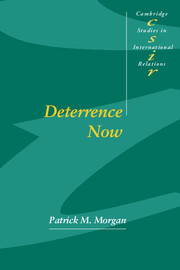Book contents
- Frontmatter
- Contents
- Acknowledgments
- List of abbreviations and acronyms
- Preface
- 1 History: deterrence in the Cold War
- 2 Deterrence and rationality
- 3 General deterrence
- 4 Testing, testing, one … two … three
- 5 Collective actor deterrence
- 6 The revolution in military affairs and deterrence
- 7 Deterrence in the post-Cold War world
- 8 Some conclusions
- References
- Index of names
- Index of subjects
- CAMBRIDGE STUDIES IN INTERNATIONAL RELATIONS
7 - Deterrence in the post-Cold War world
Published online by Cambridge University Press: 22 September 2009
- Frontmatter
- Contents
- Acknowledgments
- List of abbreviations and acronyms
- Preface
- 1 History: deterrence in the Cold War
- 2 Deterrence and rationality
- 3 General deterrence
- 4 Testing, testing, one … two … three
- 5 Collective actor deterrence
- 6 The revolution in military affairs and deterrence
- 7 Deterrence in the post-Cold War world
- 8 Some conclusions
- References
- Index of names
- Index of subjects
- CAMBRIDGE STUDIES IN INTERNATIONAL RELATIONS
Summary
This chapter offers an overview of how the nature and functions of deterrence in international politics have begun to change, applying themes of preceding chapters to contemporary concerns. To more clearly identify what has changed and what has not, I briefly review deterrence during the Cold War, then try to characterize the international system today with deterrence in mind. Then the discussion moves to the heart of the subject. One theme is that deterrence is now of sharply diminished relevance in relations among developed countries, and of continuing or rising relevance in other places. The other recurring theme is that deterrence theory will be poorly applicable to the most likely contingencies not only due to difficulties with the theory, explored in chapter 2, but because central concepts can't be operationalized in a satisfactory way by policy makers in the situations they will confront. This applies to concepts of rationality, credibility, stability, unacceptable damage – nearly every facet of deterrence. As a result, a consistently effective deterrence strategy is impossible. It is not that deterrence can't or won't work if used, but trying to guide its use by an overall strategy will not work well.
Deterrence in the Cold War era
As indicated in chapter 1, deterrence during the Cold War existed simultaneously in three forms. The first was as an old, well-known tactic in managing a relationship, just a variant of using your elbows. Deterrence/compellance is as old as international politics, natural for confronting competitors in a dangerous environment.
- Type
- Chapter
- Information
- Deterrence Now , pp. 238 - 284Publisher: Cambridge University PressPrint publication year: 2003

